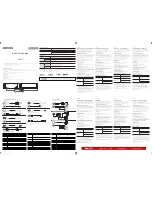
Service/maintenance
Chapter 7
OPERATION MANUAL
V2.4.0en/09.08.21//1.30
Minichiller®
51
During an active circulation, the thermal fluid circuit is shut off by shut-off valves
MATERIAL DAMAGE TO THE CIRCULATING PUMPS INSTALLED IN THE TEMPERATURE CONTROL UNIT
Do not close the thermal fluid circuit during an active circulation by means of shut-off valves.
Warm the thermal fluid to room temperature before stopping the circulation.
7.3.1
Thermal fluid replacement
Mixing different thermofluids in a thermal fluid circuit
PROPERTY DAMAGE
Do
not
mix different types of thermofluid (such as mineral oil, silicone oil, synthetic oil, water,
etc.) in a thermofluid circuit.
The thermal fluid circuit
must
be rinsed when changing from one type of thermal fluid to an-
other. No residues of the previous type of thermal fluid may remain in the thermal fluid circuit.
7.3.1.1
Externally closed application
Observe the following when replacing the thermal fluid:
→
Page 39, section
externally closed application«
. The draining and filling operations are described in this section.
7.3.2
Rinsing the thermal fluid circuit
Setpoint and overtemperature protection are not adjusted to the thermofluid
MORTAL DANGER FROM FIRE
The cut-out value of the overtemperature protection
must
be adapted to the thermofluid. Set the
cut-out value of the overtemperature protection 25 K below the fire point of the thermofluid.
The setpoint set during rinsing
must
be adjusted to the thermofluid used.
Non-compliance with the safety data sheet for the thermal fluid to be used
INJURIES
Risk of injury to the eyes, skin, respiratory tract.
The safety data sheet for the thermal fluid to be used must be read prior to using it and its
content must be respected.
Observe the local regulations/work instructions.
Wear your personal protective equipment (e.g. temperature-resistant safety gloves, safety
goggles, safety footwear).
Danger of slipping because floor and work area are contaminated. Clean the workplace; ob-
serve the proper disposal of thermal fluid and aids.
→
Mixing different thermofluids in a thermal fluid circuit
PROPERTY DAMAGE
Do
not
mix different types of thermofluid (such as mineral oil, silicone oil, synthetic oil, water,
etc.) in a thermofluid circuit.
The thermal fluid circuit
must
be rinsed when changing from one type of thermal fluid to an-
other. No residues of the previous type of thermal fluid may remain in the thermal fluid circuit.
The inner components of the temperature control unit must be dried out Need to avoid boiling
retardation during future uses (e.g. use of a silicone oil at temperatures above about 100
°C).
Example: Connecting a
short circuit hose
Содержание MPC Minichiller 280
Страница 1: ...MPC Minichiller...
Страница 2: ......
Страница 3: ...OPERATION MANUAL MPC Minichiller...
Страница 4: ......
Страница 10: ...OPERATION MANUAL Minichiller V2 4 0en 09 08 21 1 30 10...
Страница 59: ...Annex Chapter 9 OPERATION MANUAL V2 4 0en 09 08 21 1 30 Minichiller 59 9 Annex...










































